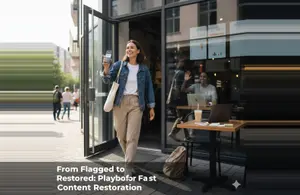- Pinterest debuts Top of Search ads, surfacing brand placements directly in the most clicked areas of search results.
- Early testing shows a 29% higher click-through rate and 32% greater chance of new shopper engagement.
- Local inventory ads now link visual discovery to real-time, nearby product availability, driving higher in-store visits.
- Media Network Connect integrates retailer first-party data into Pinterest Ads Manager, advancing retail media partnerships.
- The updates solidify Pinterest’s role as a visual commerce hub for Gen Z, where 39% prefer to begin product searches.
The new format ensures brands appear in the most influential moments of product discovery.
Pinterest is sharpening its positioning as the internet’s visual shopping engine, announcing a suite of ad innovations at its Pinterest Presents global advertiser summit. The centerpiece is the introduction of Top of Search ads, a format that inserts brand campaigns into the most influential zones of the platform’s search results.
This is more than an incremental tweak—it represents a deliberate strategy to capture Gen Z’s unique shopping behaviors, which prioritize inspiration and imagery over text queries.
Why Top of Search Ads Matter
Search behavior on Pinterest reflects a discovery mindset: 96% of the platform’s top searches are unbranded, and nearly half of all clicks (45%) occur within the first ten search results.
These conditions make the search environment both high-intent and uniquely open to product discovery. By embedding paid placements at this critical juncture, Pinterest ensures advertisers can intercept shoppers when they are most receptive.
According to Pinterest, initial testing demonstrates clear performance gains. Top of Search ads delivered a 29% higher average click-through rate and a 32% higher likelihood of reaching new users compared to standard campaigns. For brands competing in crowded categories, this positions the format as a critical visibility lever.
Linking Online Discovery With Offline Shopping
Pinterest is also scaling local inventory ads, a format designed to close the gap between digital discovery and physical retail. These units surface real-time product availability and pricing within a user’s local store radius, a critical factor for convenience-driven shoppers. Early results suggest a measurable lift in in-store traffic and efficiency.
This feature plays into Pinterest’s broader thesis: consumers are not just browsing for inspiration, they are actively bridging the journey from digital intent to real-world purchase. By embedding availability and proximity into its ad products, Pinterest brings itself closer to the transactional end of the funnel.
Media Network Connect: Retail Data Integration
Beyond new ad formats, Pinterest unveiled Media Network Connect, a self-service tool inside Ads Manager. The feature allows retail media networks to securely share first-party audience data, product catalogs, and conversion insights directly with advertising partners on Pinterest.
This integration addresses a persistent challenge for advertisers: fragmented workflows across platforms. By consolidating retail data within Pinterest’s ecosystem, brands can design data-driven campaigns that merge retailer intelligence with visual discovery signals. Early partners include Kroger Precision Marketing and Instacart Ads, both emphasizing the importance of speed and control in today’s competitive retail media environment.
Christine Foster, SVP at Kroger Precision Marketing, noted that the tool empowers advertisers with “Faster decision-making and control, while using purchase-based audiences direct from the retailer.”
This framing underscores Pinterest’s ambition to not just facilitate inspiration, but to anchor itself in measurable, purchase-linked outcomes.
Positioning Pinterest in a Fragmented Search Landscape
These moves arrive at a time when social search and retail media are converging into a dominant discovery channel. For Gen Z especially, Pinterest serves as a hybrid platform—39% report they prefer starting their shopping searches on Pinterest, a higher share than many traditional search engines.
By marrying unbranded discovery moments with precise retail targeting, Pinterest is carving a distinct identity within an ecosystem increasingly defined by AI-driven answers and short-form entertainment feeds. The updates reinforce its ambition to become not just a place for inspiration, but a commerce engine with measurable conversion power.
A Platform Doubling Down on Its Strengths
Pinterest’s latest announcements signal a deepening of its visual-first commerce strategy. With Top of Search ads targeting high-intent moments, local inventory ads bridging online-offline journeys, and Media Network Connect anchoring retail data, the platform is expanding its value proposition for advertisers and users alike.
The underlying message is clear: while traditional search remains text-driven, Pinterest is betting that the future of commerce is visual—and that Gen Z, already entrenched in these behaviors, will validate that thesis at scale.



